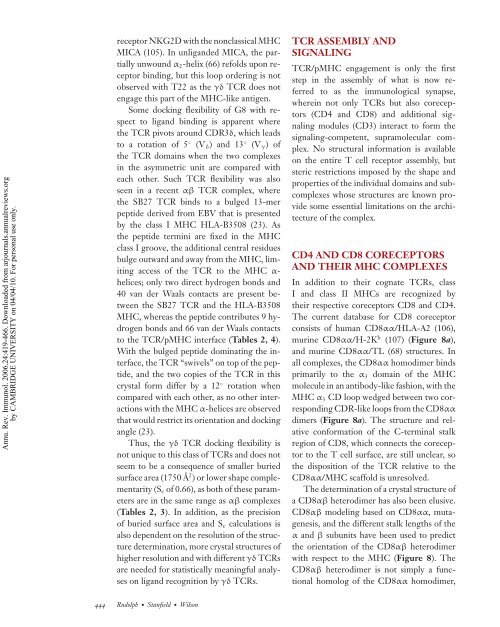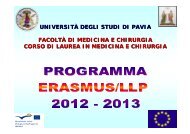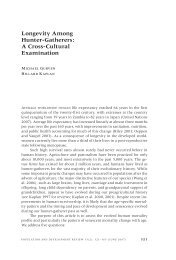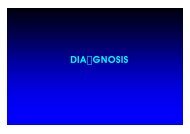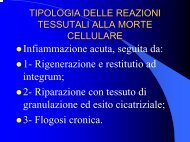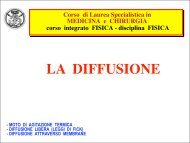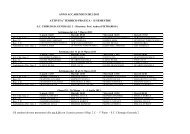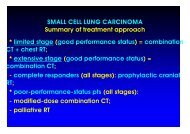Rudolph MG
Rudolph MG
Rudolph MG
You also want an ePaper? Increase the reach of your titles
YUMPU automatically turns print PDFs into web optimized ePapers that Google loves.
Annu. Rev. Immunol. 2006.24:419-466. Downloaded from arjournals.annualreviews.org<br />
by CAMBRIDGE UNIVERSITY on 04/04/10. For personal use only.<br />
receptor NKG2D with the nonclassical MHC<br />
MICA (105). In unliganded MICA, the partially<br />
unwound α2-helix (66) refolds upon receptor<br />
binding, but this loop ordering is not<br />
observed with T22 as the γδ TCR does not<br />
engage this part of the MHC-like antigen.<br />
Some docking flexibility of G8 with respect<br />
to ligand binding is apparent where<br />
the TCR pivots around CDR3δ, which leads<br />
to a rotation of 5◦ (Vδ) and 13◦ (Vγ) of<br />
the TCR domains when the two complexes<br />
in the asymmetric unit are compared with<br />
each other. Such TCR flexibility was also<br />
seen in a recent αβ TCR complex, where<br />
the SB27 TCR binds to a bulged 13-mer<br />
peptide derived from EBV that is presented<br />
by the class I MHC HLA-B3508 (23). As<br />
the peptide termini are fixed in the MHC<br />
class I groove, the additional central residues<br />
bulge outward and away from the MHC, limiting<br />
access of the TCR to the MHC αhelices;<br />
only two direct hydrogen bonds and<br />
40 van der Waals contacts are present between<br />
the SB27 TCR and the HLA-B3508<br />
MHC, whereas the peptide contributes 9 hydrogen<br />
bonds and 66 van der Waals contacts<br />
to the TCR/pMHC interface (Tables 2, 4).<br />
With the bulged peptide dominating the interface,<br />
the TCR “swivels” on top of the peptide,<br />
and the two copies of the TCR in this<br />
crystal form differ by a 12◦ rotation when<br />
compared with each other, as no other interactions<br />
with the MHC α-helices are observed<br />
that would restrict its orientation and docking<br />
angle (23).<br />
Thus, the γδ TCR docking flexibility is<br />
not unique to this class of TCRs and does not<br />
seem to be a consequence of smaller buried<br />
surface area (1750 ˚A 2 444<br />
) or lower shape complementarity<br />
(Sc of 0.66), as both of these parameters<br />
are in the same range as αβ complexes<br />
(Tables 2, 3). In addition, as the precision<br />
of buried surface area and Sc calculations is<br />
also dependent on the resolution of the structure<br />
determination, more crystal structures of<br />
higher resolution and with different γδ TCRs<br />
are needed for statistically meaningful analyses<br />
on ligand recognition by γδ TCRs.<br />
<strong>Rudolph</strong>· Stanfield· Wilson<br />
TCR ASSEMBLY AND<br />
SIGNALING<br />
TCR/pMHC engagement is only the first<br />
step in the assembly of what is now referred<br />
to as the immunological synapse,<br />
wherein not only TCRs but also coreceptors<br />
(CD4 and CD8) and additional signaling<br />
modules (CD3) interact to form the<br />
signaling-competent, supramolecular complex.<br />
No structural information is available<br />
on the entire T cell receptor assembly, but<br />
steric restrictions imposed by the shape and<br />
properties of the individual domains and subcomplexes<br />
whose structures are known provide<br />
some essential limitations on the architecture<br />
of the complex.<br />
CD4 AND CD8 CORECEPTORS<br />
AND THEIR MHC COMPLEXES<br />
In addition to their cognate TCRs, class<br />
I and class II MHCs are recognized by<br />
their respective coreceptors CD8 and CD4.<br />
The current database for CD8 coreceptor<br />
consists of human CD8αα/HLA-A2 (106),<br />
murine CD8αα/H-2K b (107) (Figure 8a),<br />
and murine CD8αα/TL (68) structures. In<br />
all complexes, the CD8αα homodimer binds<br />
primarily to the α3 domain of the MHC<br />
molecule in an antibody-like fashion, with the<br />
MHC α3 CD loop wedged between two corresponding<br />
CDR-like loops from the CD8αα<br />
dimers (Figure 8a). The structure and relative<br />
conformation of the C-terminal stalk<br />
region of CD8, which connects the coreceptor<br />
to the T cell surface, are still unclear, so<br />
the disposition of the TCR relative to the<br />
CD8αα/MHC scaffold is unresolved.<br />
The determination of a crystal structure of<br />
a CD8αβ heterodimer has also been elusive.<br />
CD8αβ modeling based on CD8αα, mutagenesis,<br />
and the different stalk lengths of the<br />
α and β subunits have been used to predict<br />
the orientation of the CD8αβ heterodimer<br />
with respect to the MHC (Figure 8). The<br />
CD8αβ heterodimer is not simply a functional<br />
homolog of the CD8αα homodimer,


